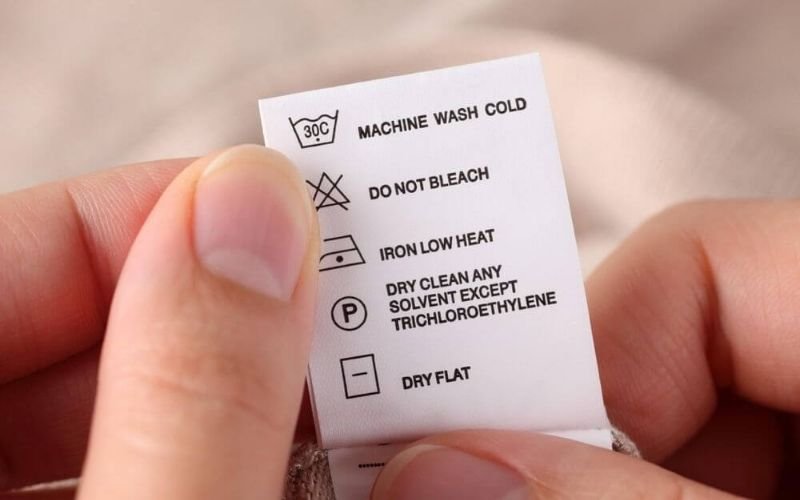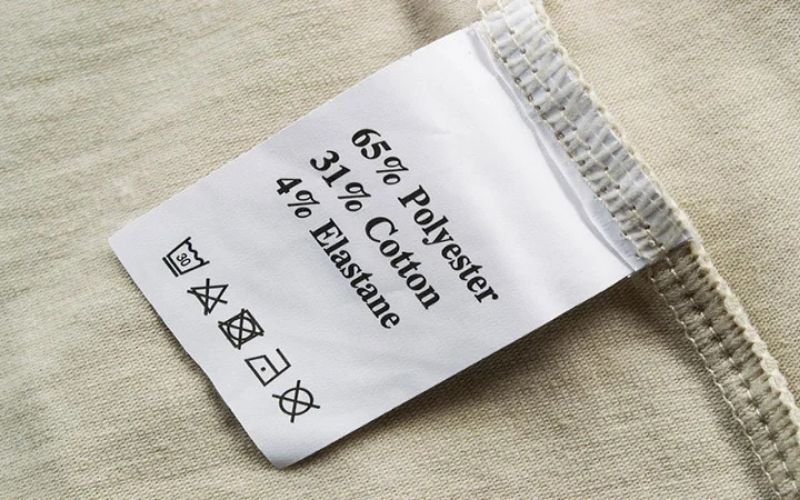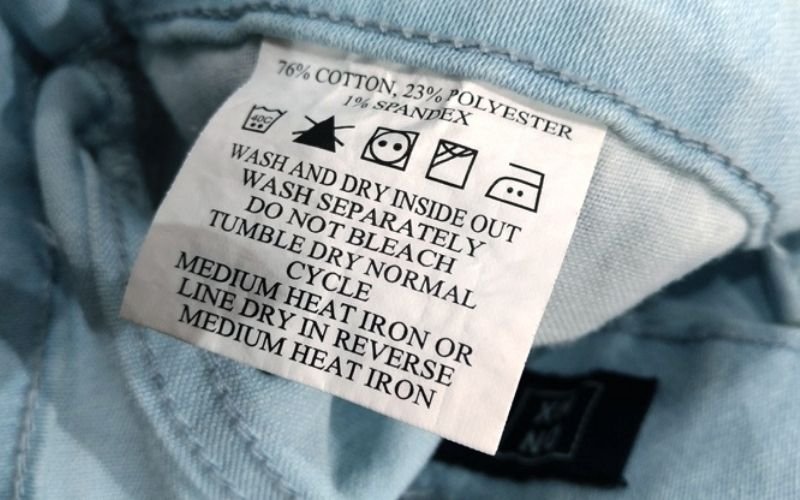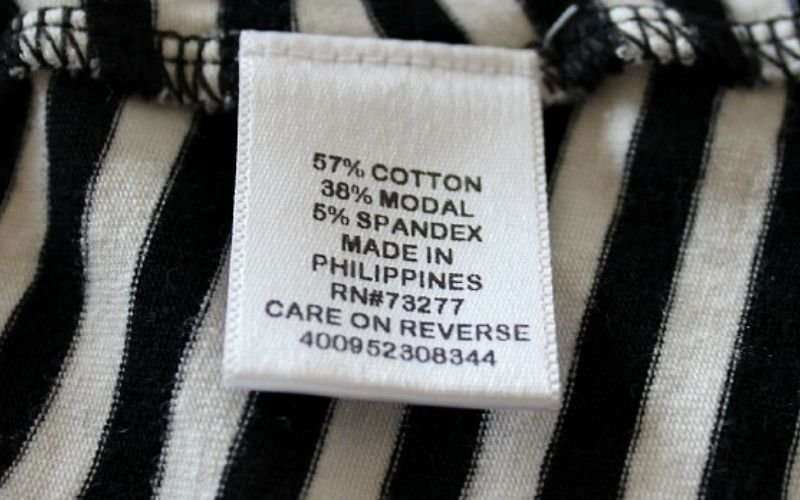Decoding Fabric Content Labels: US Compliance
Navigating the world of apparel labeling can seem daunting, especially for small businesses entering or operating within the US market. Fabric content labels are a critical piece of this puzzle, mandated by United States law under the purview of the Federal Trade Commission (FTC).
These labels must accurately convey specific information, primarily the fiber content (what the garment is made of), the country of origin (where the garment was produced), and manufacturer identification (who is responsible for the product).
This guide is designed to cut through the complexity, offering clear, practical steps and insights derived from extensive industry knowledge to help your business achieve full compliance. Getting labeling right isn’t just about following rules; accurate fabric content labels are essential for avoiding potentially steep fines and building crucial trust with your customers, forming a foundation for sustainable business success.
1. Why fabric content labels are non-negotiable for your clothing brand
Attaching fabric content labels to your apparel isn’t merely a good practice; it’s a fundamental requirement for selling clothing in the United States. Understanding the significance behind these labels is crucial for any clothing brand, regardless of size.
- Legal mandates: First and foremost, fabric content labeling is governed by FTC rules. These aren’t optional guidelines but strict legal requirements enforced by the Federal Trade Commission. Key legislation includes the Textile Fiber Products Identification Act (TFPIA), which covers most clothing and textile articles, and the Wool Products Labeling Act (WPLA), specifically addressing items containing wool. Failure to adhere to these regulations means operating outside the law. Achieving compliance isn’t just about avoiding trouble; it’s a baseline necessity for market participation.
- Building trust: In today’s market, consumer trust is invaluable. Providing a clear and accurate material breakdown on your labels offers critical transparency. This allows customers to make informed decisions based on fiber content, potential allergens, desired fabric performance, and perceived quality. When consumers understand what they are buying, it builds confidence in your brand and fosters loyalty. This transparency is often viewed as a hallmark of ethical business practices, enhancing your brand’s reputation.
- Avoiding penalties: Non-compliance with FTC labeling regulations carries significant risks. The potential penalties can be substantial, including hefty fines levied per violation (meaning each incorrectly labeled garment could incur a penalty). Furthermore, incorrectly labeled goods can be stopped and detained by U.S. Customs and Border Protection (CBP), leading to costly delays and logistical nightmares. Beyond the financial implications, the damage to your brand’s reputation can be long-lasting and difficult to repair. Investing the effort to ensure accurate labeling from the start is far more cost-effective than dealing with the consequences of non-compliance.

2. The legal landscape: Understanding the FTC and key regulations
Understanding the regulatory environment is key to ensuring textile law compliance. In the United States, the Federal Trade Commission (FTC) serves as the primary agency for enforcing labeling requirements for clothing and other textile products.
The FTC’s mission in this area is twofold: to protect consumers from deceptive practices and to ensure fair competition among businesses by requiring truthful and accurate information disclosure. Several key regulations form the backbone of these requirements:
- Textile Fiber Products Identification Act (TFPIA): This is the foundational act covering most clothing and household textile items (excluding those containing wool, which fall under the WPLA). Its main objective is to mandate the clear and accurate disclosure of fiber content (by percentage), the country of origin, and the identity of the manufacturer or another responsible business.
- Wool Products Labeling Act (WPLA): This act specifically governs wool products, meaning any item containing wool, recycled wool, or specialty wool fibers (like cashmere or camel hair). While sharing principles with the TFPIA regarding origin and manufacturer identification, the WPLA has distinct rules, most notably requiring the disclosure of any wool content, regardless of percentage.
- Care Labeling Rule: It’s also important to be aware of the Care Labeling Rule, also enforced by the FTC. This rule mandates that manufacturers and importers provide consumers with instructions on how to properly care for garments (washing, drying, ironing, etc.). While often found on the same physical label as fabric content information for convenience, the Care Labeling Rule addresses how to clean the item, whereas the TFPIA and WPLA address what the item is made of. Both are typically required for compliant apparel.
| Act Name | Primary Scope |
|---|---|
| Textile Fiber Products Identification Act (TFPIA) | Most apparel and household textile items (excluding wool products) |
| Wool Products Labeling Act (WPLA) | Products containing any amount of new wool, recycled wool, or specialty wool |
2.1. Requirement 1: Accurate fiber content breakdown
Accurately disclosing the fiber composition is a cornerstone of compliant labeling. This garment material list, often referred to as the textile make-up or fabric specification tag, must adhere to specific FTC guidelines:
- Use generic fiber names: You must use the official generic fiber names established by the FTC (e.g., ‘polyester’, ‘rayon’, ‘cotton’). Brand names or trademarks (like Dacron® or Lycra®) cannot substitute for the generic name in the content list, although they can sometimes be used alongside it (more on that later). The FTC recognizes fiber names established by the International Organization for Standardization (ISO) standard 2076:2010 as well. A list of approved generic names is available on the FTC website.
- Specify percentages by weight: The label must list the percentage of each fiber present in the product by its weight. These percentages by weight must total 100%, with minor tolerances allowed for unavoidable variations in manufacturing.
- List in descending order: Fibers must be listed vertically in descending order based on their weight percentage. The fiber that makes up the largest portion of the garment’s weight appears first, followed by the next largest, and so on.
- The 5% rule and its exceptions: Generally, any fiber constituting less than 5% of the total fiber weight does not need to be listed by its generic name. These minor fibers can be grouped together and listed as ‘Other Fiber(s)’ with their combined percentage (e.g., “3% Other Fibers”). However, there are critical exceptions to this 5% rule:
Wool: Any amount of wool or recycled wool must always be disclosed by its specific name and percentage, regardless of how small the quantity, as mandated by the Wool Products Labeling Act.
Functional significance: If a fiber present at less than 5% has a specific function that impacts the product’s performance or characteristics (e.g., spandex added for stretch), you can list its generic name and percentage. For example, a label could read “97% Cotton, 3% Spandex” even though spandex is below 5%, because its presence provides a significant functional benefit (stretch) that consumers value knowing. If you choose not to list a functional fiber under 5%, you cannot make claims about its function elsewhere on the label or in advertising.
- “100%” vs. “all”: For items made entirely of one fiber, you can state either “100% [Fiber Name]” or “All [Fiber Name]”. For instance, “100% Cotton” and “All Cotton” are both acceptable.
- Exclude non-fibrous materials: Items like buttons, zippers, sequins, interfacing, elastic cores (if completely covered), and other non-fibrous components are generally not included in the fiber weight calculation or listed on the content label, unless they are made primarily of textile fibers and meet specific criteria (which is uncommon for these typical hardware items).

2.2. Requirement 2: Clear country of origin declaration
Identifying the country of origin is another mandatory element for apparel sold in the US. This tells the consumer where the garment underwent significant manufacturing processes.
- Determining origin: The country of origin is the nation where the product was principally manufactured or underwent substantial transformation. For items made entirely in one country, this is straightforward. For complex global supply chains, determining the correct origin can involve understanding where the garment took its final form or where the most significant assembly occurred. U.S. Customs and Border Protection (CBP regulations) provide the definitive rules for determining origin, especially in complex cases involving multiple countries.
- “Made in USA” claims: This designation has very strict criteria. To label a product “Made in USA,” it must be all or virtually all made in the United States from materials that are also domestic. This means the final assembly and most of the components must be of US origin. Simply finishing or performing minor assembly on imported goods in the US is generally insufficient for a “Made in USA” claim. Misusing this label is a common pitfall leading to compliance issues.
- Imported goods labeling: For imported items, the label must clearly state the country of origin using unambiguous terms. Examples include “Made in China,” “Made in Vietnam,” or “Product of Italy.” If a garment is made using imported fabric but significantly transformed or assembled in the US, specific qualified claims are necessary, such as “Made in USA of Imported Fabric” or “Assembled in USA from components of [Country]”.
- Language requirement: The country of origin declaration must appear in English. Additional languages are permissible but do not replace the English requirement.
2.3. Requirement 3: Identifying the manufacturer or dealer
The label must identify the business responsible for the garment. The FTC provides two options for fulfilling this manufacturer identification requirement:
- Full company name: You can use the full, registered company name under which the business legally operates. This should be the name recognized in official business filings.
- Registered identification number (RN): Alternatively, you can use a registered identification number (RN), often referred to simply as an RN number. This is a unique number issued by the FTC specifically to US businesses involved in manufacturing, importing, distributing, or selling textile, wool, or fur products. Using the RN number is optional; the company name is always a valid alternative.
To obtain an RN number, businesses can apply online via the FTC website; the process is free. Once issued, the RN number can be used on all textile products handled by that specific company, even across different brands they might own.
Benefits of using an RN include potentially saving space on smaller labels or maintaining privacy regarding specific suppliers or manufacturing partners if the RN belongs to an importer or dealer rather than the direct factory.
2.4. Basic formatting essentials
Beyond the required content, the physical clothing label itself must meet basic formatting standards to ensure the information is useful to the consumer:
- Clarity/legibility: The information must be easy to read. This implies using a reasonable font size and sufficient contrast between the text and the label background. Tiny print or low-contrast colors that make reading difficult are not compliant.
- Conspicuousness: The label must be easily findable by the consumer before they make a purchase. It shouldn’t be hidden in an obscure location requiring excessive searching. It needs to be placed where a potential buyer can readily notice it during examination of the garment.
- Durability: The label carrying the required information (fiber content, origin, manufacturer ID) must remain securely attached and legible at least until the point of sale to the final customer. Unlike care labels, which ideally should last the garment’s useful life, the primary requirement for the fabric content informative attribute focuses on pre-purchase accessibility. It must withstand normal handling in a retail environment without becoming detached or unreadable before the consumer buys the item.

2.5. Handling exceptions and special materials
While the core rules cover most garments, the FTC provides specific guidance for handling common exceptions and materials that require nuanced labeling:
- Trimmings and decoration: Trim generally refers to components like collars, cuffs, waistbands, belts, ribbons, lace, or appliques added to a garment. For decorative trim (serving primarily an aesthetic purpose), there’s a trim exemption. If the trim constitutes 15% or less of the garment’s total surface area AND you make no claims about its fiber content, you can list the main body’s fiber content followed by the phrase “Exclusive of Decoration”. If the decorative trim exceeds 15% of the surface area, or if you choose to highlight its material (e.g., “silk trim”), then its fiber content must be disclosed.
- Ornamentation: This typically refers to fibers added to a fabric for a decorative effect, often creating patterns or textures within the fabric structure itself (distinct from attached trim). There’s an ornamentation exemption based on fiber weight. If the ornamentation fibers constitute 5% or less of the total fiber weight, you can list the base fabric content followed by “Exclusive of Ornamentation”. If ornamentation exceeds 5%, its fiber content must be disclosed, often requiring sectional disclosure.
- Linings and fillings: The need for disclosure depends on function. If linings or fillings are purely for structural purposes (like interfacing in a collar), their fiber content generally doesn’t need disclosure unless specific claims are made about them. However, if linings or fillings are included primarily for warmth (common in outerwear), their fiber content must be disclosed separately. This usually requires sectional disclosure (e.g., “Shell: 100% Nylon; Lining: 100% Polyester; Filling: 100% Down”).
- Sectional disclosure: This method is used when a garment consists of distinct sections with different fiber compositions that require separate identification. This is common for:
Garments with different fabrics for body vs. sleeves or panels.
Items requiring lining/filling disclosure (as above).
Products where trim or ornamentation exceeds exemption limits.
The label should clearly identify each section and its corresponding fiber content (e.g., “Body: 80% Cotton, 20% Polyester; Sleeves: 100% Cotton”).
- Wool and cashmere: As covered by the WPLA and recent Wool Act amendments, disclosure of wool is always mandatory. Specific definitions apply: cashmere must meet certain fiber fineness (micron) standards. The term “recycled wool” must be used for wool reclaimed from previously woven or felted products. Descriptors for fine wools (like “Super 100s”) are also regulated based on average fiber diameter.
- Premium fibers: When using premium cottons like Pima Cotton or Egyptian Cotton, accurate labeling is essential. If a garment is 100% Pima cotton, label it “100% Pima Cotton”. If it’s a blend, you must state the percentages truthfully, for example: “100% Cotton (consisting of 50% Pima Cotton, 50% Upland Cotton)” or more simply “50% Pima Cotton, 50% Upland Cotton”. Avoid vague terms like “Pima blend” without specifying the actual percentage, as this can be misleading according to the disclosure requirement.
- Fiber trademarks: Trademarks (like Lycra®, Tencel®, Coolmax®) can appear on the content label, but only if the corresponding generic fiber name is listed immediately adjacent to it, and the trademark is no more conspicuous (e.g., same font size) than the generic name. For example: “80% Polyester, 20% Lycra® Spandex”. The generic name remains the primary identifier for the fiber composition list.

3. Location matters: Proper placement of fabric content labels
Where you place the fabric content label on a garment is just as important as the information it contains. The fundamental rule for label placement is that the required information must be easily accessible and readable for the consumer before they decide to purchase the item. Labels shouldn’t be hidden in seams or obscure locations that require significant effort to find.
For specific types of garments, the FTC has a distinct requirement:
- Necked garments rule: For garments with a neck opening (like shirts, blouses, sweaters, jackets), the country of origin label must be placed on a label affixed to the inside center of the neck area. This could be midway between the shoulder seams or near any other label already present in the center back neck.
- Flexibility for other information: While the country of origin has this specific neck placement rule for relevant garments, the fiber content and manufacturer/dealer identification can either be on the same neck label or on a separate garment tag located elsewhere, provided that second tag is also conspicuous and easily accessible (e.g., a side seam label). Many brands consolidate all required information onto a single label for efficiency, but splitting the information across two accessible labels (like a neck label for origin/brand and a side seam label for content/care) is also compliant as long as all mandatory details are present in an accessible location before purchase.

4. Compliance for small businesses: Avoiding common pitfalls
Achieving consistent labeling compliance can be challenging, particularly for small brands juggling numerous aspects of production and sales. Awareness of common errors and proactive steps can prevent costly issues related to FTC enforcement.
Common errors to avoid:
- Making assumptions and premises or guessing fiber percentages instead of confirming with suppliers.
- Using incorrect or non-generic fiber names, especially with complex blends.
- Forgetting to include the country of origin.
- Incorrectly applying the “Made in USA” standard.
- Using labels that are difficult to read (too small, poor contrast) or not securely attached.
- Omitting either the full company name or the RN number.
The cost of non-compliance:
Failing to meet FTC labeling requirements is not a minor oversight. It can lead to significant fines, potentially reaching thousands of dollars per violation penalty. Beyond fines, non-compliant goods can be delayed or seized by customs, disrupting supply chains and causing reputational damage. The logical relationships are clear: the cost of ensuring compliance upfront is minimal compared to the potential financial and business impacts of getting it wrong.
Practical tips for compliance:
- Demand supplier info: Always obtain detailed fiber composition sheets from your fabric suppliers for every batch. Don’t rely on verbal assurances.
- Calculate carefully: If combining different materials in production, understand how to accurately calculate the final weight percentages for the finished garment.
- Maintain record keeping: Keep thorough records of fabric specifications, label proofs, and supplier documentation. This is crucial if questions arise later.
- Choose partners wisely: Consider working with label manufacturers or consultants familiar with US FTC regulations.
- Integrate checks: Build label verification into your production workflow and quality control processes. Check proofs carefully before mass production.
- Understand guaranties: While suppliers can provide guaranties that the information they provide is accurate, the FTC notes these can sometimes be difficult to obtain or enforce. Ultimately, the responsibility for compliant labeling often rests with the importing or selling brand. Diligence is key.
4.1. What’s the difference between a fabric content label and a care label?
It’s essential to distinguish between these two required labels, although they are often combined onto one physical tag for convenience. The fabric content label primarily tells you what the garment is made of. Governed by the Textile Act and Wool Act, it discloses the fiber composition, country of origin, and manufacturer identity.
Conversely, the care label tells you how to clean and maintain the garment. Mandated by the Care Labeling Rule, it provides instructions for washing, drying, ironing, bleaching, and dry cleaning necessary to avoid damaging the item. While both are FTC requirements, they serve different informational purposes for the consumer.

4.2. How do I label a garment made from a blend of fibers?
Labeling a garment made from a blend of different fibers follows the core rules outlined earlier. First, identify all fibers present that constitute 5% or more of the total garment weight. List these using their generic names in descending order by weight percentage.
Any fibers making up less than 5% of the weight should generally be grouped together and listed as “Other Fiber” (if only one) or “Other Fibers” (if multiple), followed by their combined aggregate percentage. Remember the exceptions: wool must always be listed, and functional fibers (like spandex) can be listed even if below the 5% rule threshold. For example, a correct label might read: “60% Cotton, 37% Polyester, 3% Other Fibers” or, if spandex provides stretch: “96% Cotton, 4% Spandex”.
4.3. Can I put fabric content information on a hang tag instead of a sewn-in label?
No, the mandatory information – fiber content, country of origin, and manufacturer ID – cannot solely rely on a hang tag. FTC rules require this information to be on a label affixed securely to the garment itself (like a sewn-in label or a securely heat-sealed one) in a way that it remains attached until the point of sale to the consumer. Hang tags are easily removable and are generally considered temporary or promotional.
However, if a hang tag does mention fiber content (e.g., highlighting a specific fiber), it must either contain the full required fiber disclosure statement or clearly direct the consumer to the permanent label (e.g., “See sewn-in label for full fiber content”).
An exception exists for items made of only one fiber, where a hang tag stating “100% Cotton” (for example) doesn’t necessarily trigger the need for the full redirection statement, provided the permanent label is also compliant. But relying only on the hang tag for required info violates FTC rules.
4.4. Do I need an RN number to sell clothes in the US?
No, obtaining and using an RN number is optional for selling clothes in the US. The FTC requirement is to provide manufacturer ID on the label, and businesses have a choice: they can use either their full registered company name or their FTC-issued RN number.
The decision of which identifier to use is up to the business. Some prefer the RN number for label space savings or supply chain privacy, while others prefer using their company name for branding consistency. You do not need both, and you are compliant as long as one of these valid identifiers is present on the label. RN numbers are free to obtain from the FTC for eligible US businesses.
Read more:
Ensuring accurate and compliant fabric content labeling is far more than just a regulatory hurdle; it’s a fundamental aspect of responsible business operations and a tangible business asset. As we’ve detailed, proper labeling under FTC regulations like the Textile Act and Wool Act is a legal necessity, protecting your brand from potentially significant penalties and disruptions. More importantly, it fosters consumer trust by providing transparency about the products you sell, contributing positively to your brand’s reputation and trustworthiness.
Viewing labeling compliance not merely as a cost or obligation, but as an integral part of professional branding and customer assurance, shifts the perspective. It demonstrates a commitment to quality and transparency that resonates with today’s consumers. Understanding the nuances of fiber disclosure, origin declaration, manufacturer identification, and proper placement is key to navigating the US market successfully.
Navigating these details is vital. If you require personalized guidance on label design or ensuring compliance for your specific products, resources like Pack Love are available to assist apparel businesses. Taking labeling seriously is an investment in your brand’s integrity and long-term success.






















